MAC's Believe It Or Not!
by John McDougald
Reprinted from "Crown Jewels of the Wire", November 1992, page 18
As I've traveled around the country for the last ten years, I've taken lots
of pictures. My motto has become "have camera, will travel!" I spent a
little time this month looking through the pictures that I've taken in the past
year or so to see what new information I could share with you regarding some
styles, some embossings and some colors that you may not have seen. In addition,
I want to get some feedback on one of the CD issues that continues to raise
questions.
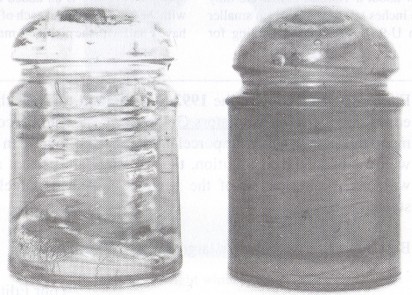
First we'll deal with some Styles:
1) CD 127 - On the left is what I would
consider the standard style for a CD 127. It's one of the many Brookfield three
line embossings that appears in this style. On the right is a piece that I had
not seen before. It is an unembossed CD 127 with one of the most pronounced lips
under the wire groove that I have seen. In addition the skirt is perfectly
vertical. Those two unusual attributes are further enhanced by the fact that
this piece is a nice deep green-aqua. (Hopefully, you can see the color contrast
between the light aqua Brookfield) Altogether, a neat new find that Mike Bliss
shared with me at the Cedar Rapids National.
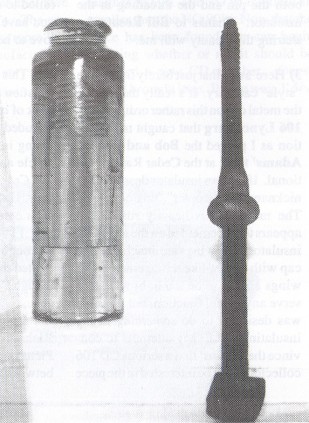
2) When Carol and I published our reference book two years ago, the jury was
still out on the "Slim Pin", at least with regard to the
appropriateness of its appearance in the CD listing. These pictures help clarify
why it belongs in the CD listing, where it now appears as CD 141.5. The history
of these pieces goes back to the mid-seventies when a group of these, maybe
15-20, were found in Lake Erie. To the best of my knowledge, no other specimens
have ever been found, and no specific function has been attributed to these
insulators. They are interesting in that the wire groove can only carry a light wire and yet the length of the skirt implies a need for
high linear electrical resistance. One theory that has been suggested is that
since these pieces were found in the water, they may have been used to carry
antennas on ships. The purpose of the long skirt was to help shed the water in
an obviously wet environment. You be the judge on that theory.
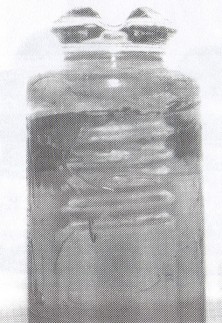
These pictures
highlight two very interesting characteristics of this particular Slim Pin.
First, it's mint. I've probably seen twelve of these over the years, and this is
by far the best one I know of. (If you need proof, look at page 315 of our
reference book.) Second, the pin has been successfully removed. This gives us a
good look at both the pin and the threading in the insulator. Thanks to Bill Rosato for
sharing this beauty with me.
3) Here's one that just barely falls in the "style" category. It's
really the style of the metal cap on this rather ordinary CD 106 Lynchburg that
caught my attention as I passed the Bob and Phoebe Adams' table at the Cedar
Rapids National. If ever an insulator deserved the nickname
"helicopter", this one does. The metal cap is heavily rusted and
appears to be cemented on the top of the insulator. The wings are attached to
the cap with a rivet-like arrangement. The wings appear to be too light weight
to serve any useful function, but I think it was designed to do something in the
insulating field. My attempts to convince the Adams' that a serious CD 106
collector might be interested in the piece failed to achieve my desired effect. If you have any ideas about this one,
I'd love to hear from you.
4) This great insulator answered a question that had been lingering in the
back of my mind for nearly 15 years. I included the CD 106 Gayner NO.91 listing
in our book on the basis of an article and picture that appeared in an old Cross
Arms magazine in the mid 70's. Unfortunately, the picture wasn't clear enough to
make out the embossing. I knew Editor Jim Garrity to be a thorough researcher,
however, and I trusted the accuracy of the listing even though I'd never seen
the piece personally.
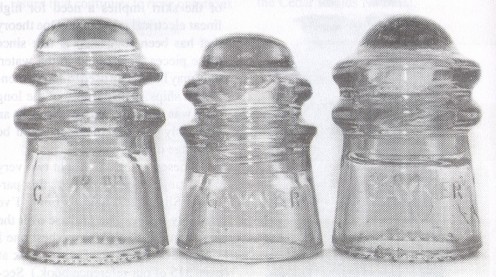
Last year's Eastern Regional and Richard Wentzel ended the
mystery. Pictured is a CD 106?? Gayner NO.91 between two regular CD 106 Gayner NO.90's. (Take a look at the wire grooves on the two NO.90's. The one on the
left has a newer look, more like the CD 107's some manufacturer's made.) The
close-up (below) should leave no doubt that there is, in fact, a Gayner NO.91.
The NO.91 is quite a bit smaller than the NO.90's. Now that the piece
has been found, we can begin debating whether or not it should be assigned a new
CD number. Oops! Sorry I brought it up. By the way, I'd be interested to know if any more of these are out there in collections.
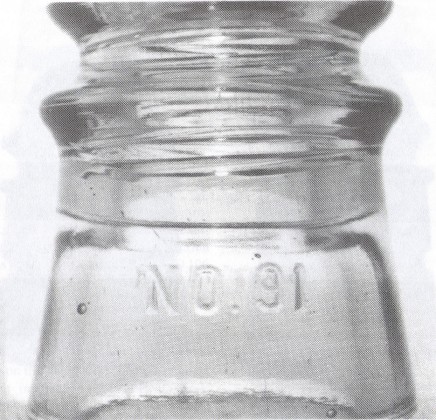
Close up photograph of the embossing on a Gayner No. 91.
Color Variations
4) You may wonder why I decided to try to demonstrate color variations in a
black and white publication. Again, I hope the picture explains my logic. Until
this spring, all of the CD 113 Brailles I had ever seen ranged in color from dark purple to royal purple. My visit to the Western Regional in
Enumclaw expanded my knowledge and may be news to you, too. On the left, a
beautiful royal purple Braille; on the right a cloudy, off clear Braille with
purple and burgundy tints. I'm told by the local experts that there are a
handful of these in existence. This one belongs to Mark Lauckner -- a real
beauty.
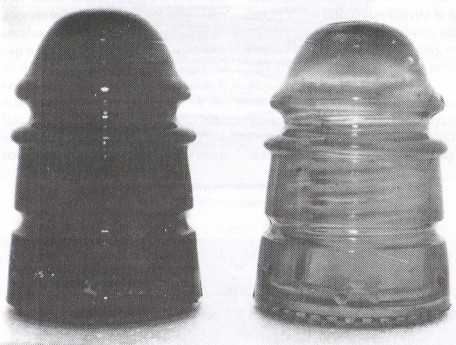
Embossings
5) Thanks to Bill Meier for sharing this one with me. It's a beautiful purple
tint Hemingray No.12. The difference here is that there is a clear second line
of embossing with "HE" appearing directly below the "HE"
in
HEMINGRAY. I examined this one carefully, and I'm convinced it's not a 'ghost
embossing' . It looks to me like the engraver cut two letters and decided there wasn't enough room for a second
line of embossing so he moved up the mold and started over. (How's that for a
theory?) If you're a trivia buff and you have the time, you can find this
listing in one of the old references books from the late 60' s. Let me know if
you happen to find it.
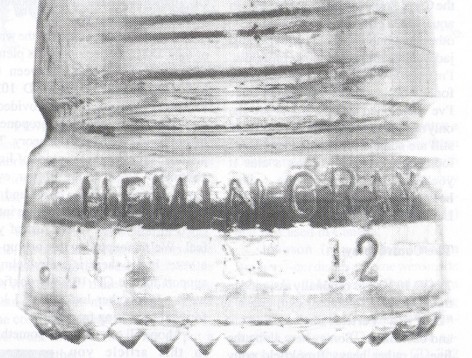
6) Here's another piece I was introduced to at the Eastern Regional last
year. I must say that my introduction was with mixed feelings as this CD 106 gem
(remember who the CD 106 collector is) was changing hands, and none of the hands
were mine. Dick Bowman found this one in a collection and had promised it to
Bill Meier. The embossing on the back of this otherwise common insulator is
"PATENT/MAY 1893". What makes this embossing really neat is that not
only is there no "2", there isn't even any room for a "2".
The MAY is jammed right up against the 1893. Here's my theory. This mold was
embossed on May 1, 1893. Hemingray was still waiting for patent approval and was
sure it was imminent, but didn't want to put the wrong date on the patent, so
they just put the month and the year. BELIEVE IT OR NOT! --- NOT!!!!!
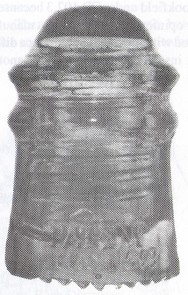
(P.S. I was fortunate enough to pick up two of these for my own collection at
the Carol Stream show this year. One in aqua was a gift from Rob Lloyd. The
other, in a bubbly, snowy aqua, almost jade, came from Mike McLaughlin. I'm
usually very careful about checking for embossing errors, and yet the three I've
mentioned in this article are the only ones I ever remember seeing. There still
are some sleepers out there if you look hard enough. Here's a clue if you're
looking for one of these --- it's a heavier, thicker mold than normal. Good
Luck! P.P.S...... Thanks Rob and Mike.)
The Controversy
7) CD 102.3 was originally assigned to the KCGW (No Name) with either a
"Dot" or a "Vertical Bar" on the front and back skirts.
Somewhere along the line, a rather heavy Brookfield pony was also assigned this
CD Number. In my current listing, I don't include the Brookfield under CD
102.3 because, in my opinion, the piece was not manufactured with the intent of
making a different insulator. Rather, it's just another of the many variations of Brookfield ponies, all of which are catalogued as
CD 102's (We're not talking about CD 101's here.)
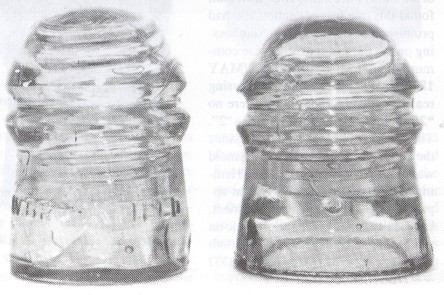
Needless to say, I incurred
the wrath of the CD 102 collectors. This picture shows the comparison between
the heavy Brookfield and the CD 102.3 KCGW. These pieces were provided to me by
Jim Doty, one of the proponents of the CD 102.3 Brookfield theory. The picture
demonstrates the merit of Jim's argument. The sizes are similar, even though the
shape of the dome and the wire grooves are different. I'd be interested in how
some of the rest of you feel. We're not putting this one up for a vote, but if
there is overwhelming support for the CD 102.3 Brookfield, we'll take another
look at it. I look forward to hearing from you.
I hope all of you found
something in this article you haven't seen before. That's why I take all of
those pictures, in case you were wondering. BELIEVE IT OR NOT!
| 